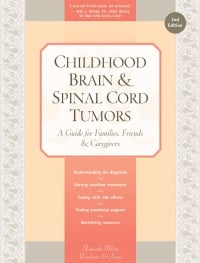Childhood Brain and Spinal Cord Tumors
Chapter 23: Recurrence
Hold fast to dreams
For if dreams die
Life is a broken winged bird
That cannot fly.
— Langston Hughes
CHILDHOOD BRAIN AND SPINAL CORD TUMORS are different than other childhood cancers because periods of active treatment often alternate with observation in an attempt to “do no harm.” Sometimes tumors never regrow. But if they do regrow, there are either new treatments to try or perhaps already-existing treatments that couldn’t be given earlier (such as radiation, if the child is now older than age 3). The terms the doctor might use are recurrence (reappearance of a tumor that previously disappeared with treatment) or progression (an increase in the size of an existing tumor).
Parents frequently describe the recurrence or progression of their child’s tumor as more devastating than the original diagnosis. They sometimes feel betrayed, guilty, and/or angry. They worry that if the previous treatments didn’t work, what will? Mostly, they are afraid. And their often unspoken but most crushing fear is: What if my child dies?
If your child’s tumor has returned or grown, it is worth remembering that you now have several strengths you didn’t have before. You have already done this. You know the language, and you have a relationship with the medical team. You probably have friendships with other parents of children with brain or spinal cord tumors and you know they will be there for you. You can also hope that during the time your child’s tumor was in remission researchers were able to develop newer and more effective treatments. You know that something that seems insurmountable can be endured, one day at a time.
This chapter describes signs and symptoms of recurrence or progression, what emotional responses you can expect, and how to set goals and decide on a treatment plan. In addition, several parents and patients share their stories about how they managed to cope.
Table of Contents
All Guides- Introduction
- 1. Diagnosis
- 2. The Brain and Spinal Cord
- 3. Types of Tumors
- 4. Telling Your Child and Others
- 5. Choosing a Treatment
- 6. Coping with Procedures
- 7. Forming a Partnership with the Treatment Team
- 8. Hospitalization
- 9. Venous Catheters
- 10. Surgery
- 11. Chemotherapy
- 12. Common Side Effects of Chemotherapy
- 13. Radiation Therapy
- 14. Peripheral Blood Stem Cell Transplantation
- 15. Siblings
- 16. Family and Friends
- 17. Communication and Behavior
- 18. School
- 19. Sources of Support
- 20. Nutrition
- 21. Medical and Financial Record-keeping
- 22. End of Treatment and Beyond
- 23. Recurrence
- 24. Death and Bereavement
- 25. Looking Forward
- Appendix A. Blood Tests and What They Mean
- Appendix C. Books and Websites

